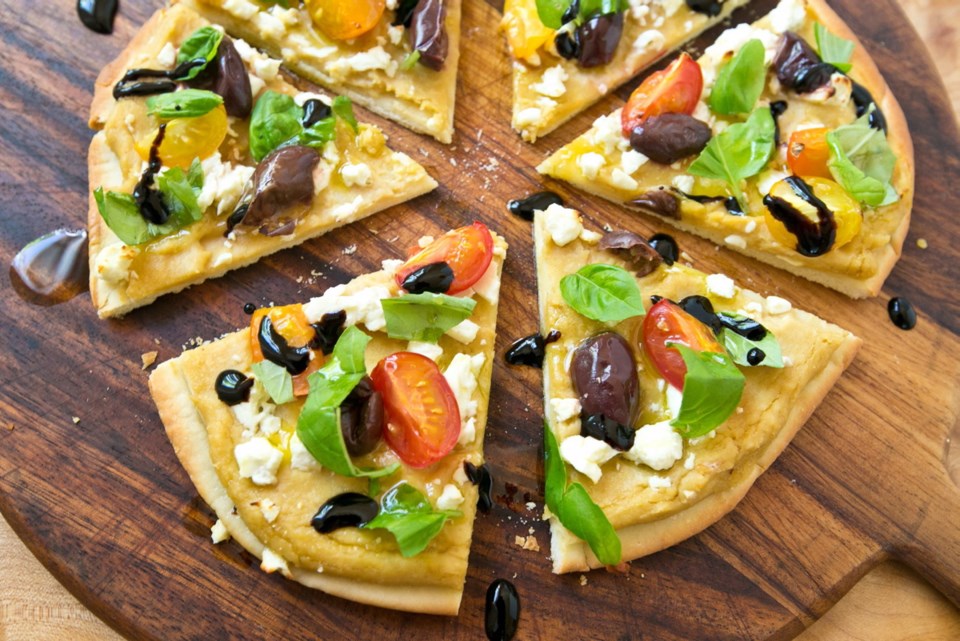 Back in January, I wrote a story on food trends and among the items I listed was hummus. I noted then, that it wasn’t long ago that the only place you could buy it was at a Middle Eastern or Mediterranean specialty food store.
Back in January, I wrote a story on food trends and among the items I listed was hummus. I noted then, that it wasn’t long ago that the only place you could buy it was at a Middle Eastern or Mediterranean specialty food store.
That has certainly changed — these days, every supermarket sells multiple brands. In fact, one store I went to dedicated an entire refrigerater shelf to hummus.
But why have these tubs of open-and-eat hummus become so popular?
Let’s start by describing what hummus is.
Hummus, which has other spellings, such as homous, is the Arabic word for chickpea. That indicates two obvious clues indicate what the key ingredient is and where this Middle Eastern-style dip/spread was first made.
After cooking, the chickpeas are blended with flavourings such as garlic, olive oil, lemon and tahini (sesame seed paste). The resulting mixture has a smooth texture and a rich taste, but not an overpowering one, thanks to the mild-tasting chickpeas.
It’s because of that taste that hummus appeals to a lot of palates, both young and old, which is why you’ll see both kids and adults happily snacking on hummus.
Many people also like spreads and dips, and hummus works as both.
Another reason folks like eating hummus is because the chickpeas used to make it are an excellent source of protein and fibre, along with potassium, calcium, niacin and vitamin B6. Chickpeas, unlike other pulses, such as beans, also have a lower oligosaccharide content, making them easier to digest and less likely to cause flatulence.
Making hummus at home is easy if you have a food processor, or even an immersion (hand) blender. All you need to do is blend the ingredients until smooth.
So why would anyone buy hummus?
The answer is because it’s convenient.
Doing so eliminates the need to buy the ingredients required to make hummus and clean up afterward. It also comes in package sizes that one can use up in one go or in a reasonable amount of time, while a homemade hummus recipe may yield more than you need.
Tubs of store-bought hummus are generally fairly well made and budget-friendly, around five to six dollars for a 200-gram or larger tub, depending on the brand.
Another reason people, including me, like to buy hummus is because it can quickly be used to add flavour to another dish. Below, I’ve listed five simple ways to do that.
Note: If you do want to make your own hummus for the uses suggested today, check my out my recipe for it on the Times Colonist website, timescolonist.com. To find it, search Eric Akis: The secret to silky hummus
Five ways to use store-bought hummus
• Serve hummus warm and top it: Warm some hummus (1/2 cup per person makes a nice serving) in the microwave, or in a small pan on the stove, with a splash of orange juice or stock. Spoon it onto a plate and top it as you might warm polenta, with sautéed scallops, prawns or fish, meatballs, the meat from a kebab, or grilled lamb chops. Now accent your creation with some fresh herb leaves and a drizzle of balsamic and olive oil.
• Spread hummus in a sandwich or wrap: Instead of mayonnaise, use hummus as a spread on a sandwich or wrap.
• Swirl hummus into soup: For added flavour and nutrition, for a creamy look without the cream, and/or to give a soup a thicker texture, swirl a few spoons of hummus into it near the end of cooking.
• Fill things with hummus: Make tasty bites by filling such things as celery sticks, cherry tomatoes, endive leaves or cucumber rounds with hummus.
• Make hummus salad dressing: Make a quick, thick and creamy-style salad dressing by whisking 1/2 cup hummus with 2 Tbsp extra virgin olive oil, 1 Tbsp lemon juice, 1 Tbsp orange juice and 1 tsp honey. Season the dressing with salt and pepper and, if desired, swirl in 1 Tbsp of something chopped and green, such as parsley, basil or oregano.
Mediterranean-style Pita Pizza
Hummus-spread, Greek-style pita, olives and olive oil, basil, tomatoes, feta and balsamic vinegar give this easy-to-make pizza a rich and inviting Mediterranean-style taste. Make a meal of the pizza by serving it with a simple green salad.
Preparation: 20 minutes
Cooking time: 10 to 12 minutes, per batch
Makes: four pita pizzas
4 Greek-style pita (see Note)
2 cups hummus (about 400 grams)
150 grams feta cheese, crumbled
20 to 24 pitted black olives, each halved
12 cherry tomatoes, each quartered
• freshly ground black pepper, to taste
24 to 32 fresh basil leaves, each torn in half
• olive oil and balsamic vinegar, to taste
Preheat the oven to 425 F. Line two large baking sheets with parchment. Set two pitas on each baking sheet. Spread the top of each pita with 1/2 cup of hummus. Divide and arrange the cheese, olives and tomatoes on the hummus. Sprinkle each pizza with some pepper.
Bake the pizzas, one sheet at a time, 10 to 12 minutes, or until the toppings are hot and the bottom of the pita is crispy.
Top each pizza with some basil, and then drizzle with a little olive oil and balsamic vinegar. Cut and enjoy the first two pizzas while you bake the other two.
Note: Greek-style, also called souvlaki, pita, which has no pocket, is available in the deli section of most supermarkets.
Eric’s options: If desired, you could also top these pita pizzas with meat, such as shredded cooked chicken, thin strips of proscuitto, or crumbled bits of cooked Italian or chorizo sausage. You could also top it with other vegetables, such as roasted peppers or arugula.
Lamb and Hummus Meatballs in Minty Citrus Tomato Sauce
For dinner, try serving these hummus-flavoured meatballs with orzo, a small, rice-shaped pasta, and a steamed green vegetable such as, broccoli or snap peas. You could also serve these meatballs in pita bread, with toppings such as crumbled feta cheese, diced onion, shredded lettuce and pitted olives.
Preparation time: 25 minutes
Cooking time: About 30 minutes
Makes: four (six meatballs each) servings
For the meatballs
1 lb. ground lamb
1/3 cup hummus
3 Tbsp chopped fresh mint
1 large egg
1 tsp cornstarch
1/2 tsp salt
1/2 tsp freshly ground black pepper
1/8 tsp. cayenne pepper
Preheat oven to 375 F. Line a baking sheet with parchment paper. Combine the meatball ingredients in a bowl. Moisten your hands lightly with cold water, and then roll the meatball mixture into 24, about 1 1/2-inch (4 cm) balls and place on the baking sheet. Bake 20 minutes, or until cooked through. Remove from the oven and use meatballs as described below.
For the sauce and to finish
1 (14-oz.) can tomato sauce
1/4 cup orange juice
2 Tbsp lemon juice
2 tsp honey
osalt and pepper to taste
2 Tbsp chopped fresh mint
While the meatballs roast, place the sauce ingredients, except mint, in a medium-sized pot and set over medium-low heat. When the meatballs are cooked, drain well and add them to the sauce. Increase the heat until the sauce gently simmers; gently simmer the meatballs 10 minutes. Gently stir in the mint and serve.
Eric Akis is the author of The Great Rotisserie Chicken Cookbook (Appetite by Random House). His columns appear in the Life section Wednesday and Sunday.



